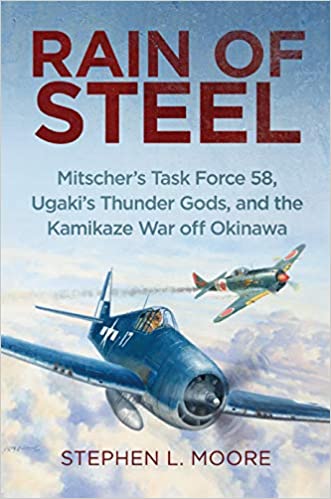Reviewed by Diana L. Ahmad, Ph.D.
Author of over a dozen books about World War II, Stephen L. Moore adds to his bibliography with a wonderful analysis of the Spring 1945 Pacific Campaign for Okinawa. As expected by the title of the work, the first chapters are devoted to telling readers who Vice Admiral Marc Andrew “Pete” Mitscher of the United States Navy and Vice Admiral Matome Ugaki of the Imperial Japanese Navy were and their significance to the Battle for Okinawa. Both men were trained in their respective nation’s naval academies and had decades of experience in their navies.
In World War II, Mitscher, a quiet man who enjoyed reading detective novels, commanded USS Hornet just before the Japanese bombed Pearl Harbor. With the ensuing war, Mitscher battled the Japanese in, for example, the Solomon Islands, Midway Island, Leyte Gulf, and the Central Pacific. Mitscher had his first experiences with kamikazes while in command of a carrier task force during the Leyte Gulf campaign in the fall of 1944. In February 1945, the Vice Admiral and Captain Arleigh Burke, Mitscher’s chief of staff, prepared Task Force 58 for battle with the Japanese at Iwo Jima. After the victory there came Okinawa. By that time, the American carriers under Mitscher were a well-oiled unit that faced little threat of being overwhelmed by the Japanese.
While Mitscher’s groups were hitting their peak, the Japanese under Vice Admiral Ugaki’s command faced a deteriorating situation with respect to raw materials, fuel supplies, and even qualified air groups. Ugaki, like Mitscher, had extensive experience in World War II. At the beginning of the war, Ugaki was Chief of Staff for Admiral Isoroku Yamamoto and helped Yamamoto plan the attack on Pearl Harbor. By 1944, he came to command the kamikaze, “divine wind,” the infamous unit whose mission was to attack Allied ships by crashing their planes into the vessels causing the death of the Japanese pilot as well as extensive damage and loss of life on the American vessels. The Kamikaze Special Attack Force flew Mitsubishi A6M fighter planes known by the Allied code name “Zekes” or commonly called “Zeros.” Ugaki pledged that he would fight until the end of the war, even if it meant he would not return alive. Ultimately, he flew his last mission after hearing that Emperor Hirohito surrendered to the Allies. His plane was shot down by American antiaircraft fire before it could do any harm to American ships.
After providing brief biographies of the two Vice Admirals, Moore devotes most of the book to the Navy and Marine pilots that fought the air battles against the Japanese. Moore interviewed several veterans of the Okinawa campaign, including Tillman “Tilly” Pool and Dean Caswell, bringing first-person accounts to the work. Moore explains the personalities of those who flew the missions, such as Lieutenant Gene Valencia, who became an “Ace in a Day” with five confirmed kills in a single mission. Valencia’s VF-9 Hellcat division, known as the “Mowing Machine” and later the “Flying Circus,” became the most successful Navy fighter division during the battle for Okinawa.
Moore makes it easy to visualize the combat between the Japanese and American fighter planes. He spares no details and explains the pilots’ strategies and bravery during their combat missions. Downed American pilots were often rescued within minutes of the plane and pilot crashing into the sea. Moore also provides stories of what being attacked by the kamikaze was like. While the book focuses on the air battles, Moore does not neglect the fighting by the Marines and Army on Okinawa.
For readers new to books about World War II in the Pacific, the author provides an excellent glossary that defines the types of planes used in the air war and gives an appendix listing all the aces of the Okinawa Campaign. There is no doubt that Mitscher brought aviation to the forefront of the Navy with his superb fighter groups. Moore’s work gives readers an excellent and detailed description of skill, bravery, and command of the seas and the air by the United States Navy in World War II.
Diana L. Ahmad is a Curators’ Distinguished Teaching Professor with the Missouri University of Science and Technology’s Department of History and Political Science. She is also a Book Review Editor for Nevada State Historical Quarterly.
Rain of Steel: Mitscher’s Task Force 58, Ugaki’s Thunder Gods, and the Kamikaze War off Okinawa (Stephen L. Moore, Naval Institute Press, Annapolis, MD, 2020)


